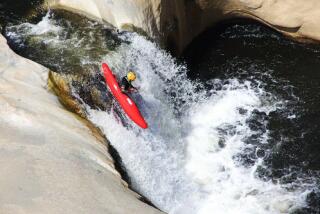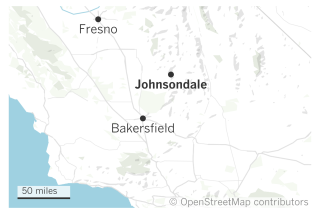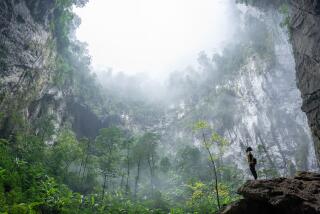Boy Survives Night in Flooded Cavern : Midwest: The 13-year-old is hospitalized after 18 hours braced on a tight ledge. Bodies of friends bumped by him in dark waters. Six from boys’ home died in cave.
ST. LOUIS — In what his family called a miracle, a 13-year-old boy from a home for the abused and the afflicted was rescued Saturday after spending nearly 18 hours in the cold, watery, pitch-black depths of a cavern, where he had crawled onto a ledge as a flash flood thundered past, throwing the bodies of his dead friends against him.
When two veteran cave explorers finally reached him, Gary Mahr, shivering and hungry, said he wanted a pepperoni pizza. He was rushed by helicopter to a children’s hospital in St. Louis, 20 miles north, where he was placed in an intensive care unit. Authorities said he was suffering from hypothermia. His grandmother said he was in good condition.
The youngster was one of five boys and two adult counselors from St. Joseph’s Home for Boys, a Catholic facility in St. Louis for the mistreated and emotionally troubled, who were exploring inside a cavern at Cliff Cave Park. All the others drowned Friday when rain sent a torrent of water through the cave. Authorities said the park was closed at the time and had been barricaded.
The dead boys were wards of the state, officials said. The Missouri Department of Social Services, the police and a St. Louis County child-death review team began investigations. County Police Chief Ron Battelle said nobody should have entered the park. The police said their findings would go to prosecutors and that the boys’ home could face criminal charges.
The Rev. P. Joseph Buckley, executive director of the home, took issue with those who said the park had been closed and barricaded. In a prepared statement, Buckley said there were no signs at the park indicating it was closed. He said boys from the home had visited the park every day last week and were never warned about the cave or told to leave.
The deaths were the largest single human tragedy in seven weeks of flooding throughout the Midwest, where the death toll has climbed to 41. Crop and property damage stood at more than $10 billion. More than 30,000 people were homeless. The weather forecast was for still more heavy rain--as much as six inches in some places.
In St. Louis, crews reduced Mississippi River leakage under the city’s flood wall by 90%. Officials said they expected to have the flow stopped by morning. And in Des Moines, crews sandbagged the inside of the city water plant, afraid that rising floodwater might swamp it again and leave residents and businesses without water for a second time.
Most attention, however, was focused on Cliff Cave Park, where counselors from the boys’ home took 16 youngsters on an expedition Friday. They arrived about noon, officials said, and several entered the cave, not far from the Mississippi.
The cavern goes into a hill, and a torrent of rain at midafternoon sent a deluge of water down its sides. Much of the water poured through holes in the ceiling of the cave and caused a flash flood. Some rescuers described it as a wall of water five feet tall.
It caught two counselors, Darnell Redmond, 31, and Jennifer Ethard, 21, inside the cavern, along with Gary Mahr and four other boys: Emmett Terry, 9; Tarrell Battle, 10; Melvin Bell, 10; and Terrill Vincent, 12.
Their companions called for help. Rescuers found the companions in two vans parked on an access road. The rescuers rushed to the cave, where they discovered the bodies of Redmond, Terry, Battle and Bell tangled in a knot just outside the entrance.
Water poured from the mouth of the cave and rushed down toward the Mississippi. Several rescuers entered the cave, among them Charley McBride, a veteran cave explorer. He described it as about 20 feet wide and six feet high at the mouth. But he said its height and width vary greatly inside.
McBride twice fought his way 4,700 feet to the back of the cave. He found shirts, T-shirts and shoes. But he found no more bodies--nor any survivors.
Authorities said they thought that Ethard, Mahr and Vincent had been swept out of the cave and down into the Mississippi. Searchers hunted along the path of the water until 10 p.m.
They were presumed dead, and rescue efforts were halted for the night.
Matt Marciano of south St. Louis, also a veteran cave explorer who had volunteered his services, went home--but he could not sleep. He said he tossed and turned in bed and kept asking himself: “What did we miss? What could we be doing different?”
At 9 a.m. Saturday, he returned to the cave, along with 25 sheriff’s deputies, paramedics and other cave experts, including Rich Schleper of High Ridge, Mo., about 20 miles away.
Marciano and Schleper entered the cavern. They said the water flowing through it was about 60 degrees and that the air was as cold as 55 degrees. One deputy was taken away to be treated for hypothermia.
But Marciano and Schleper kept searching. They entered every nook and branch of the cave, calling out to anyone who might still be alive. “You just leave no stone unturned,” Marciano said. “You just keep going and going and going.”
Shortly after 10 a.m., they found a small branch of the cave that narrowed sharply. “We heard a noise,” Schleper said. “We first assumed that it was someone behind us.”
Then, Schleper said, a tiny voice called out: “Help!”
It came from a bowl-shaped room, about 10 feet wide and not much more than three feet high. Along the left side, near the top, was a ledge--and above it was a hollowed-out area in the ceiling.
Huddled on the ledge, with his head thrust upward into the hollow, was Mahr.
He had propped up his feet, with his toes along the edge of the hollow, to keep himself from tumbling off the shelf and into the water below.
The room was fed by the flood and by a natural spring. Its water, Marciano said, had a temperature of less than 50 degrees. Had the youngster fallen, his rescuer said, he might never have lasted.
But Mahr had clung to his perch, in a 24- to 36-inch space between shelf and ceiling, all night long. Incredibly, Marciano said, “he was in real good spirits.
“I looked at him, and I says: ‘What do you think about seeing the sun in about 150 feet?’
“He just smiled real big and said, ‘Fine!’
“So we got him through a little squeeze like, and I says: ‘OK, Gary, look up, and what do you see?’
“And he just smiled real big. And I says: ‘How’s that?’
“And he says: ‘That’s fine. I like that.’
“That is when he started to feel the warm air. He was just all smiles.”
Marciano and Schleper led the youngster to an alternate entrance to the cave and took him out that way because it was quicker. Marciano asked him if he was hungry. Mahr replied that he wanted a pizza.
Marciano said the boy’s preference was pepperoni.
Not long afterward, rescuers found the bodies of Ethard and Vincent about 300 feet farther along the same branch of the cave.
A key reason Mahr lived, Marciano said, was that he had scrambled onto the ledge and out of the torrent of the flash flood. That way, Marciano said, the boy did not “have all that pressure from the water.”
There was evidence, he said, that the flash flood had slammed the bodies of its victims around inside the cave.
Indeed, Mahr’s mother, Sharon MacRobert, 32, said that the flood had thrown some of her son’s friends into him as they struggled to stay alive.
“He heard one of them say that he was too young to die,” MacRobert said. She said there was enough light for her son to see. “He watched the water drown them,” she said. Then, after they died, the water hurled their bodies into him. “The bodies,” she said, “kept bumping against him.
“It was such a shock,” she said, “seeing the other kids who did not make it. They were his friends, and he said, ‘Mom, they died.’ ”
MacRobert said her son gave this account of the tragedy:
“Some didn’t want to go into the cave and were afraid. . . . Five boys and two counselors went in. Gary told me that, rather than stay with the kids who didn’t want to go in, he wanted to stick with the adults.
“They walked in and the water was up to their ankles. As they got farther along, some kids started to yell out, ‘It’s getting higher.’ Many started to panic. But before they could go, the water went, ‘Shoooof!’
“It came in so fast everybody got pushed under the water. When Gary got pushed under, he held his breath and waited, came up and got air and went back down. He kept going up and down, and he saw the other kids doing the same thing. But once he saw everybody in panic, he remembered what my sister, who was a lifeguard, always said: ‘Whenever you’re in a danger zone swimming, don’t panic.’
“He started feeling around for something to grab. He said his fingers felt a groove. He got hold of a piece of rock and pulled himself up. He said his life flashed by his eyes. Again he thought about not panicking, that he had to live and survive.
“After he pulled himself up, his head was at the top of the cave, and only his chin was out of the water. And that’s where he remained. He heard the rescuers coming last night and saw flashlights and hollered for help. They didn’t hear him.
“He was there alone until 10 o’clock this morning. Again he hollered, ‘Help, help!’
“He knows he was the only one to survive.”
MacRobert said juvenile authorities had sent her son to the boys’ home two months ago. “He had problems with himself. He had started dealing with the wrong people and wandering off.
“I thought it (going to the home) was the best thing.”
But from now on, she said, she wants her boy to stay at home with her.
Ruth Mahr, 85, the boy’s great-grandmother, said she prayed all night for his rescue. “I thank the Lord for saving him,” she said. “I hope they have learned a lesson: When you are warned of things, you must take heed.”
She said: “This proves that miracles do happen,” and other family members agreed.
In Des Moines, workers placed more sandbags around and inside the city water plant even though the community avoided an arc of violent thunderstorms that rumbled over the state.
Since water began running in city pipes again Thursday after two dry weeks, the pumping station has provided nearly 30 million gallons a day to residents for showers, laundry and toilet needs. Drinking water is still nearly three weeks away.
On Saturday, water plant director L.D. McMullen strained that capacity slightly, diverting more than 2 million gallons to provide water to the suburban town of Ankeny, which lost its own water supplies Friday.
The southwestern corner of Iowa caught the brunt of Saturday’s storms.
Cascading sheets of rain forced the evacuation of more than 500 people from towns along the rising Missouri and Nishnabotna rivers.
Times staff writers Stephen Braun in Des Moines and Richard E. Meyer in Los Angeles contributed to this story.
* LINGERING PROBLEMS: Flood victims are finding that removing water from their homes is a difficult process. A20
More to Read
Sign up for Essential California
The most important California stories and recommendations in your inbox every morning.
You may occasionally receive promotional content from the Los Angeles Times.










